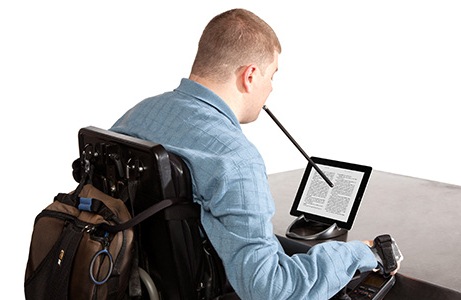. 
| Device | What it is | How it is used | Who would use it – diagnoses | Examples | Videos |
| Head control | A device that allows switches to be mounted on or near the headrest of a wheelchair. | Switches are activated by moving the head to press the switch. | Quadriplegia due to: -spinal cord injury C4-C5 -cerebral palsy -advanced multiple sclerosis -advanced muscular dystrophy |
A man with quadriplegic cerebral palsy turns on his radio by tilting his head to the side to press a switch mounted to the side of his headrest. | |
| Head pointer
|
A pointing device that is mounted to head gear. | The head gear for the device is worn on top of the head. The head is moved to maneuver the pointer. | Quadriplegia due to: -spinal cord injury C4-C5 -advanced multiple sclerosis -advanced muscular dystrophy |
A woman with advanced multiple sclerosis uses her head pointer to turn the pages of her book. | |
| Sip ‘n’ Puff switch
|
A switch that is activated by blowing or sucking on a tube. | The mouth is used to blow through the tube for some functions or suck on the tube for other functions. | Quadriplegia due to: -spinal cord injury C1-C3 -advanced amyotrophic lateral sclerosis |
A man with a C3 spinal cord injury uses a sip n puff interface to operate his computer. | |
| Track ball
|
A computer mouse that incorporates a ball held in by a socket. The ball is connected to sensors within the mouse that detect its movement | The thumb or fingers are used to roll the ball to move the pointer on the computer screen. | -spinal cord injury C7-C8 -multiple sclerosis Muscular dystrophy -cerebral palsy -advanced seizure disorder -severe traumatic brain injury (TBI) |
A boy with a severe TBI uses a track ball to move the computer cursor while doing his homework. | |
| Dual-handed keyboard
|
A keyboard with keys placed in several ergonomic positions to allow easy access to all keys. | Both hands are used to type on the keyboard. The keys are placed to allow for minimal hand and wrist movement while typing. | -spinal cord injury C7-C8 -multiple sclerosis -muscular dystrophy -severe rheumatoid arthritis |
A secretary with severe rheumatoid arthritis uses a dual-handed keyboard on her computer at work. | |
| Reading Pen
|
A pen sized text scanner. | A pen sized text scanner. | -traumatic brain injury -cognitive disorders -learning disabilities |
A high school student with a learning disability scans the large words of her science book into the reading pen and listens to the pronunciation of the words through the text to speech function. | |
| Prone stander
|
A standing table that tilts forward.
Assistive devices are placed on the front of the stander. |
The person is placed in the stander with the front of his or her torso on the supporting devices. The stander is leaned forward to facilitate extension of the body. | -cerebral palsy -traumatic brain injury -severe seizure disorder -muscular dystrophy -spina bifida |
A teenager with severe cerebral palsy uses a prone stander to participate in a group project with his classmates. |